Detection of Defects in Geomembranes Using Quasi-Active Infrared Thermography
Abstract
:1. Introduction
- (1)
- The motion of hard scumbergs underneath the membrane, typically caused by the inflow of raw sewage into the lagoons, can produce defects on the underside that are not readily detected by visual inspection; these will be referred to as non-surface-penetrating defects;
- (2)
- Large scumbergs can lift the membrane above the surface level of the sewage. Combined with the wind blowing over the elevated cover, this can laterally stretch the membrane, thus producing large strains and increasing the damaging potential of non-surface-penetrating defects.
2. IR Thermography Inspection of HDPE Geomembranes
2.1. Quasi-Active Thermography
2.2. Emissivity Assessment of HDPE Geomembrane
2.3. Experimental Set-Up
2.4. Defects in the HDPE Geomembrane with Various Substrates
3. Thermographic Data Analyses
3.1. Newton’s Cooling Law Method
3.2. Peak Logarithmic Second Derivative Method
3.3. Frame Subtraction Method
4. Results and Discussion
4.1. Case 1: Inspection of Defects on Water and Air Substrates
4.2. Case 2: Inspection of Defects on Soil and Air Substrates
5. Conclusions
- Compared to the map of temperature obtained from a single frame of the raw thermal image, the analysis based on the transient cooling process of membranes can better determine the presence of subsurface defects. The surface temperature of the membrane can be used to distinguish the substrate medium (soil, water, and air) and subsurface defects in the membrane;
- The three different thermal transient analysis methods have their own merits and limitations so that a combination of the three appears to be most suitable;
- The modified peak logarithmic second derivative and Newton’s cooling law methods show reasonable performance in distinguishing different substrates under the membrane cover, but the defect profiles are comparatively hard to identify on different substrates;
- The frame subtraction method with a predefined time interval provides the best indication of subsurface defects, especially in the presence of soil and air substrates, and the contrast values also correlate with the depth of the defects, thereby suggesting that a quantitative evaluation of defect severity may be possible.
Author Contributions
Funding
Institutional Review Board Statement
Informed Consent Statement
Data Availability Statement
Conflicts of Interest
References
- Rowe, R. Long-term performance of contaminant barrier systems. Geotechnique 2005, 55, 631–678. [Google Scholar] [CrossRef]
- Wong, L.; Vien, B.S.; Ma, Y.; Kuen, T.; Courtney, F.; Kodikara, J.; Chiu, W.K. Remote Monitoring of Floating Covers Using UAV Photogrammetry. Remote Sens. 2020, 12, 1118. [Google Scholar] [CrossRef] [Green Version]
- Rowe, R.; Rimal, S.; Sangam, H. Ageing of HDPE geomembrane exposed to air, water and leachate at different temperatures. Geotext. Geomembr. 2009, 27, 137–151. [Google Scholar] [CrossRef]
- Scheirs, J. A Guide to Polymeric Geomembranes: A Practical Approach; John Wiley & Sons: Hoboken, NJ, USA, 2009. [Google Scholar]
- Vien, B.; Wong, L.; Kuen, T.; Courtney, F.; Kodikara, J. Strain Monitoring Strategy of Deformed Membrane Cover Using Unmanned Aerial Vehicle-Assisted 3D Photogrammetry. Remote Sens. 2020, 12, 2738. [Google Scholar] [CrossRef]
- Omar, T.; Nehdi, M.L. Remote sensing of concrete bridge decks using unmanned aerial vehicle infrared thermography. Autom. Constr. 2017, 83, 360–371. [Google Scholar] [CrossRef]
- Omar, T.; Nehdi, M.L.; Zayed, T. Infrared thermography model for automated detection of delamination in RC bridge decks. Constr. Build. Mater. 2018, 168, 313–327. [Google Scholar] [CrossRef]
- Teza, G. THIMRAN: MATLAB Toolbox for Thermal Image Processing Aimed at Damage Recognition in Large Bodies. J. Comput. Civ. Eng. 2014, 28, 04014017. [Google Scholar] [CrossRef]
- Shepard, S.M.; Lhota, J.R.; Rubadeux, B.A.; Wang, D.; Ahmed, T. Reconstruction and enhancement of active thermographic image sequences. Opt. Eng. 2003, 42, 1337–1342. [Google Scholar] [CrossRef]
- Sun, J. Analysis of pulsed thermography methods for defect depth prediction. J. Heat Transf. Trans. ASME 2006, 128, 329–338. [Google Scholar] [CrossRef]
- Zeng, Z.; Li, C.; Tao, N.; Feng, L.; Zhang, C. Depth prediction of non-air interface defect using pulsed thermography. NDT E Int. 2012, 48, 39–45. [Google Scholar] [CrossRef]
- Genest, M.; Martinez, M.; Mrad, N.; Renaud, G.; Fahr, A. Pulsed thermography for non-destructive evaluation and damage growth monitoring of bonded repairs. Compos. Struct. 2009, 88, 112–120. [Google Scholar] [CrossRef]
- Hung, Y.; Chen, Y.S.; Ng, S.; Liu, L.; Huang, Y.; Luk, B.; Ip, R.; Wu, C.; Chung, P. Review and comparison of shearography and active thermography for nondestructive evaluation. Mater. Sci. Eng. R Rep. 2009, 64, 73–112. [Google Scholar] [CrossRef] [Green Version]
- Lahiri, B.; Bagavathiappan, S.; Reshmi, P.; Philip, J.; Jayakumar, T.; Raj, B. Quantification of defects in composites and rubber materials using active thermography. Infrared Phys. Technol. 2012, 55, 191–199. [Google Scholar] [CrossRef]
- Lahiri, B.; Bagavathiappan, S.; Jayakumar, T.; Philip, J. Medical applications of infrared thermography: A review. Infrared Phys. Technol. 2012, 55, 221–235. [Google Scholar] [CrossRef] [PubMed]
- Wiecek, B. Review on thermal image processing for passive and active thermography. In Proceedings of the 2005 IEEE Engineering in Medicine and Biology 27th Annual Conference, Shanghai, China, 17–18 January 2006; pp. 686–689. [Google Scholar]
- Kylili, A.; Fokaides, P.A.; Christou, P.; Kalogirou, S.A. Infrared thermography (IRT) applications for building diagnostics: A review. Appl. Energy 2014, 134, 531–549. [Google Scholar] [CrossRef]
- Scott, M.; Luttig, H.; Strydom, M.; Gonelli, M.; Kruger, D.; Rankine, R.; Broodryk, T. Passive infrared thermography as a diagnostic tool in civil engineering structural material health monitoring. In Proceedings of the Concrete Repair, Rehabilitation and Retrofitting III: 3rd International Conference on Concrete Repair, Rehabilitation and Retrofitting, ICCRRR-3, Cape Town, South Africa, 3–5 September 2012. [Google Scholar]
- Saarimäki, E.; Ylinen, P. An investigation of non-destructive thermographic inspection exploiting phase transition of water for moisture detection in aircraft structures. Proceedings of QIRT, Krakow, Poland, 2–5 July 2008. [Google Scholar]
- Vavilov, V.P.; Burleigh, D.D.; Klimov, A.G. Advanced modeling of thermal NDT problems: From buried landmines to defects in composites. In Thermosense XXIV; International Society for Optics and Photonics: Orlando, FL, USA, 2002; Volume 4710, pp. 507–521. [Google Scholar]
- Ibarra-Castanedo, C.; Genest, M.; Guibert, S.; Piau, J.-M.; Maldague, X.P.; Bendada, A. Inspection of aerospace materials by pulsed thermography, lock-in thermography, and vibrothermography: A comparative study. In Thermosense XXIX; International Society for Optics and Photonics: Orlando, FL, USA, 2007; p. 654116. [Google Scholar]
- Bergman, T.L.; Incropera, F.P.; DeWitt, D.P.; Lavine, A.S. Fundamentals of Heat and Mass Transfer, 8th ed.; Bergman, T.L., Lavine, A.S., Eds.; John Wiley & Sons, Inc.: Hoboken, NJ, USA, 2017. [Google Scholar]
- Çengel, Y.A. Heat and Mass Transfer: Fundamentals & Applications, 5th ed.; McGraw Hill Education: New York, NY, USA, 2015. [Google Scholar]
- Ma, Y.; Wong, L.; Vien, B.S.; Kuen, T.; Kodikara, J.; Chiu, W.K. Quasi-Active Thermal Imaging of Large Floating Covers Using Ambient Solar Energy. Remote Sens. 2020, 12, 3455. [Google Scholar] [CrossRef]
- FLIR. User’s Manual FLIR A6xx Series; FLIR Systems: Wilsonville, OR, USA, 2016. [Google Scholar]
- Apogee. Apogee Instruments Owner’s Manual Pyranometer Models SP-110 and SP-230; Apogee: Logan, UT, USA, 2020. [Google Scholar]
- Song, H.W.; Park, K.J.; Han, S.K.; Jung, H.S. Thermal conductivity characteristics of dewatered sewage sludge by thermal hydrolysis reaction. J. Air Waste Manag. Assoc. 2014, 64, 1384–1389. [Google Scholar] [CrossRef] [Green Version]
- Wang, K.-S.; Tseng, C.-J.; Chiou, J.; Shih, M.-H. The thermal conductivity mechanism of sewage sludge ash lightweight materials. Cem. Concr. Res. 2005, 35, 803–809. [Google Scholar] [CrossRef]
- Ding, H.-S.; Jiang, H. Self-heating co-pyrolysis of excessive activated sludge with waste biomass: Energy balance and sludge reduction. Bioresour. Technol. 2013, 133, 16–22. [Google Scholar] [CrossRef]
- Wang, Y.; Lu, Y.; Horton, R.; Ren, T. Specific heat capacity of soil solids: Influences of clay content, organic matter, and tightly bound water. Soil Sci. Soc. Am. J. 2019, 83, 1062–1066. [Google Scholar] [CrossRef]
- Zeri, M.; Alvalá, R.C.S.; Carneiro, R.; Cunha-Zeri, G.; Costa, J.M.; Rossato Spatafora, L.; Urbano, D.; Vall-Llossera, M.; Marengo, J. Tools for communicating agricultural drought over the Brazilian Semiarid using the soil moisture index. Water 2018, 10, 1421. [Google Scholar] [CrossRef] [Green Version]
- Balasubramanian, R.; Sircar, A.; Sivakumar, P.; Ashokkumar, V. Conversion of bio-solids (scum) from tannery effluent treatment plant into biodiesel. Energy Sources Part A Recovery Util. Environ. Eff. 2018, 40, 959–967. [Google Scholar]
- Thakare, K.; Vishwakarma, H.; Bhave, A. Experimental investigation of possible use of HDPE as thermal storage material in thermal storage type solar cookers. J. Res. Eng. Technol. 2015, 4, 92–99. [Google Scholar]
- Nikiforova, T.; Savytskyi, M.; Limam, K.; Bosschaerts, W.; Belarbi, R. Methods and results of experimental researches of thermal conductivity of soils. Energy Procedia 2013, 42, 775–783. [Google Scholar] [CrossRef] [Green Version]
- Kodešová, R.; Vlasakova, M.; Fer, M.; Tepla, D.; Jakšík, O.; Neuberger, P.; Adamovský, R. Thermal properties of representative soils of the Czech Republic. Soil Water Res. 2013, 8, 141–150. [Google Scholar] [CrossRef] [Green Version]
- Milhé, M.; Sauceau, M.; Arlabosse, P. Modeling of a continuous sewage sludge paddle dryer by coupling Markov chains with penetration theory. Appl. Math. Model. 2016, 40, 8201–8216. [Google Scholar] [CrossRef] [Green Version]
- Rajic, N. Principal component thermography for flaw contrast enhancement and flaw depth characterisation in composite structures. Compos. Struct. 2002, 58, 521–528. [Google Scholar] [CrossRef]
- Versaci, M.; Morabito, F.C. Image Edge Detection: A New Approach Based on Fuzzy Entropy and Fuzzy Divergence. Int. J. Fuzzy Syst. 2021, 23, 918–936. [Google Scholar] [CrossRef]
- Simi, V.R.; Edla, D.R.; Joseph, J.; Kuppili, V. Parameter-free fuzzy histogram equalisation with illumination preserving characteristics dedicated for contrast enhancement of magnetic resonance images. Appl. Soft Comput. 2020, 93, 106364. [Google Scholar] [CrossRef]
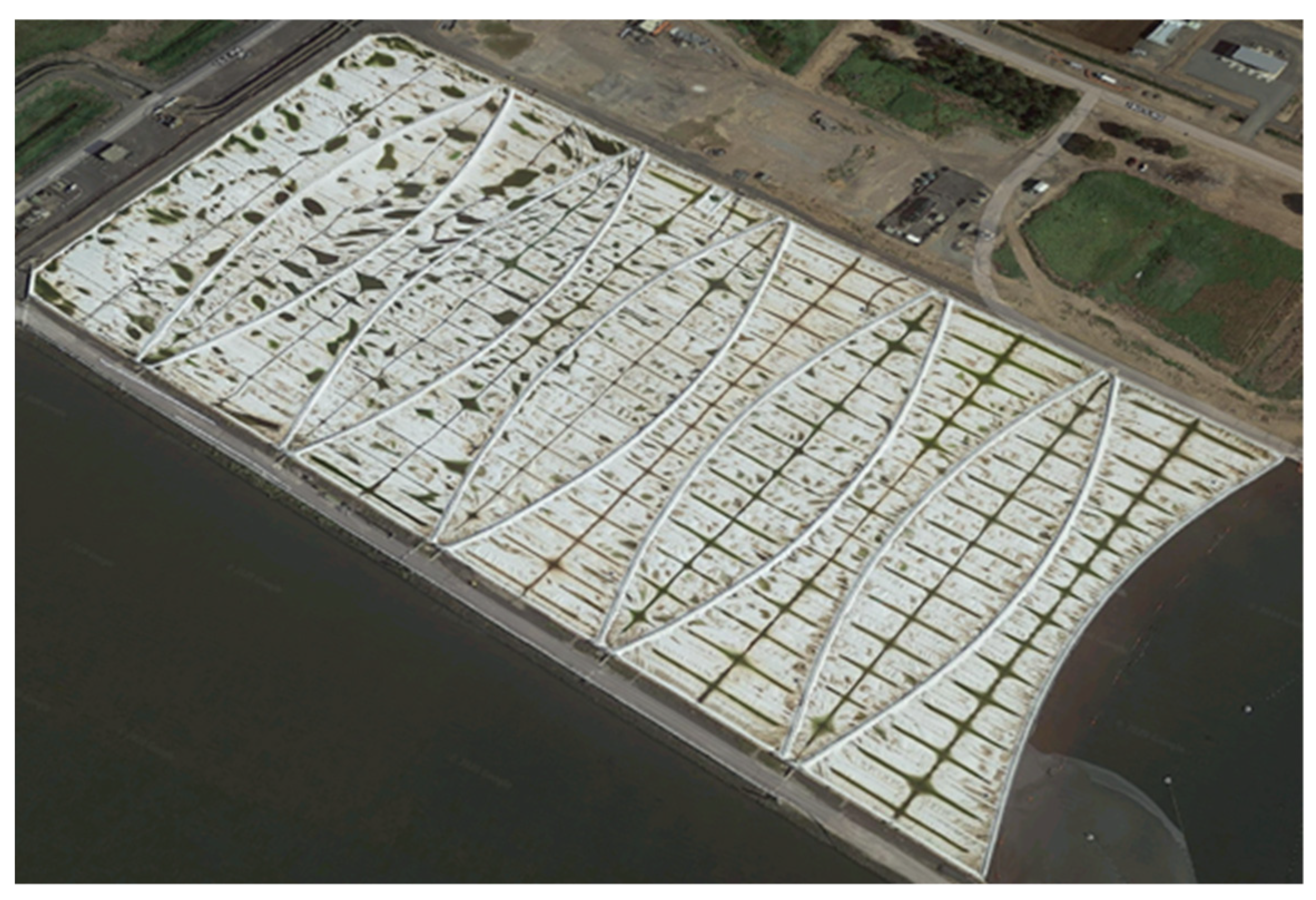
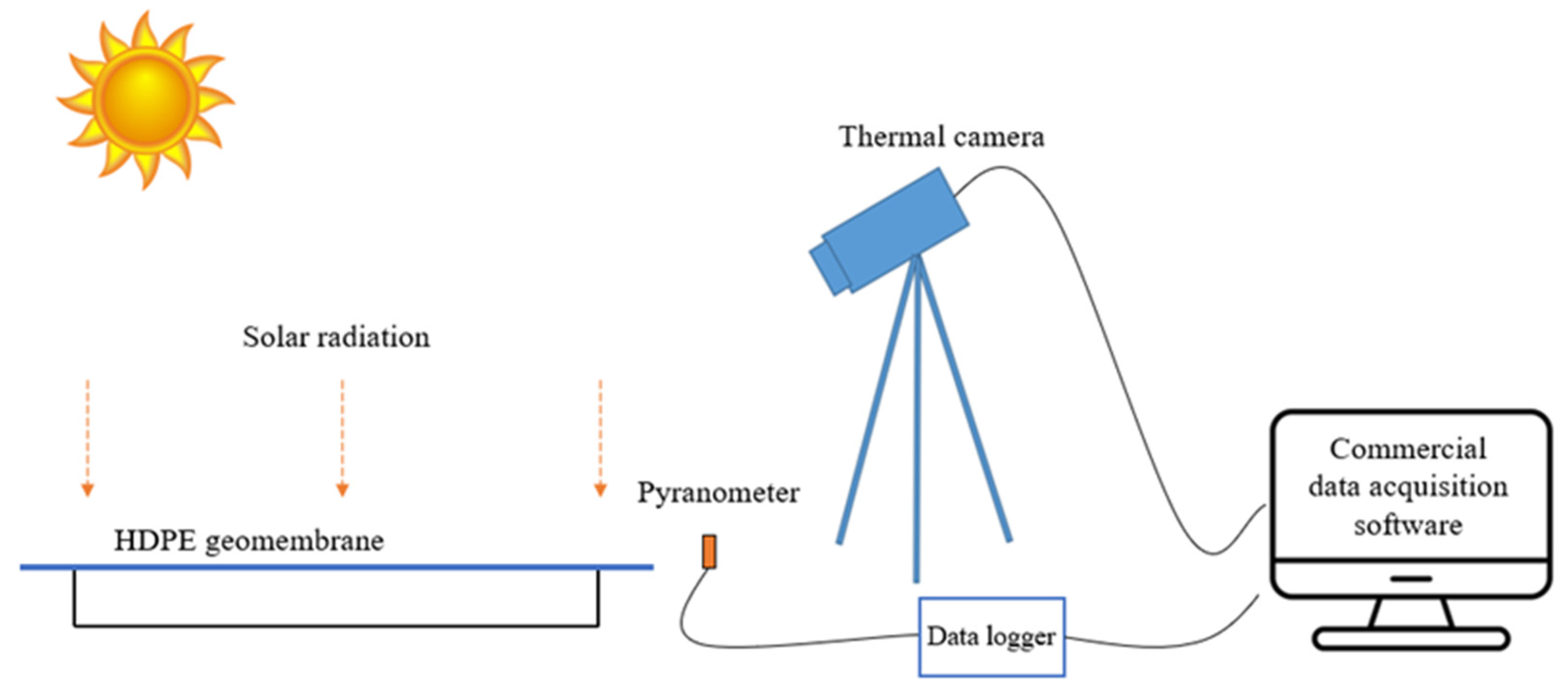

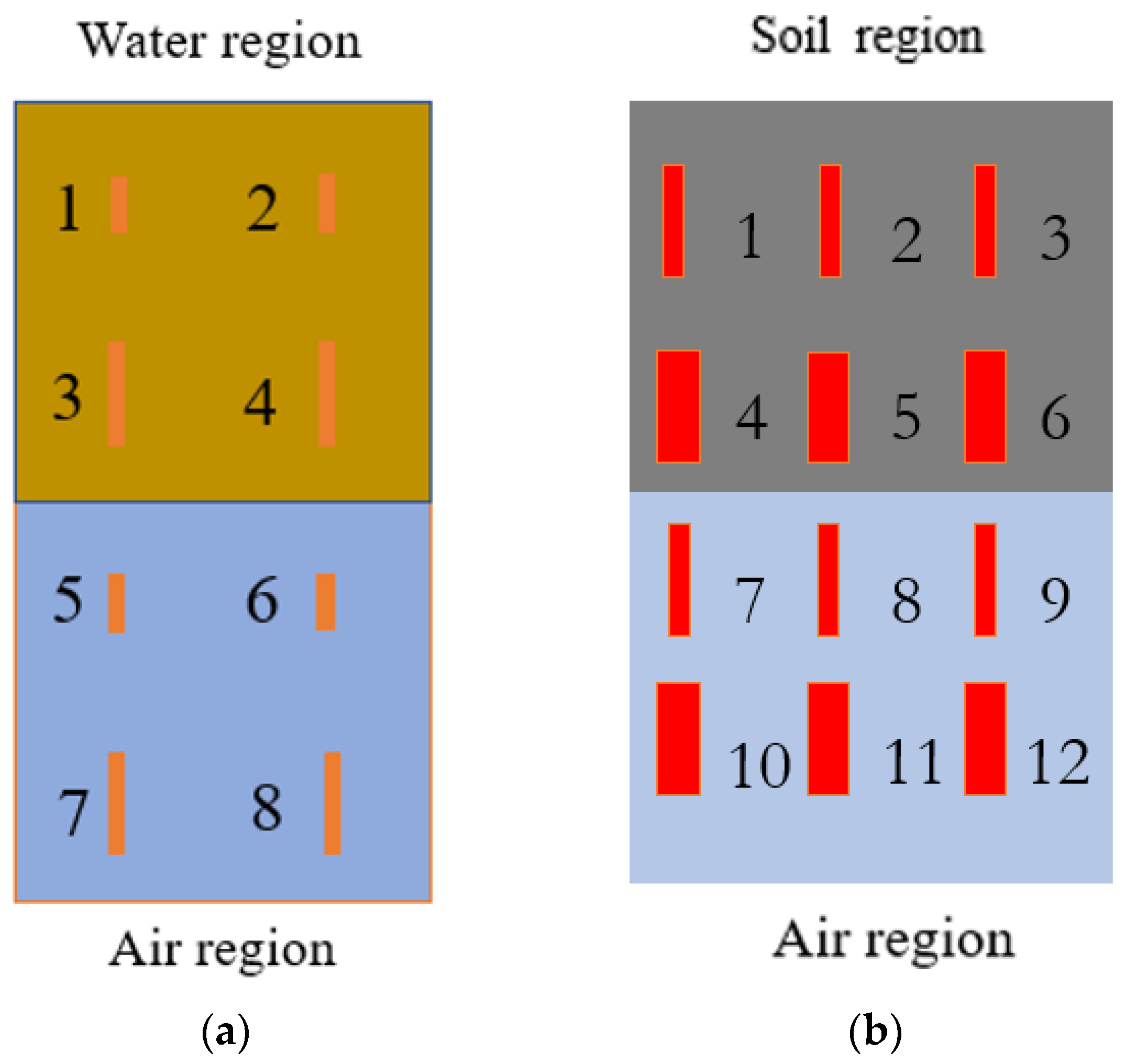
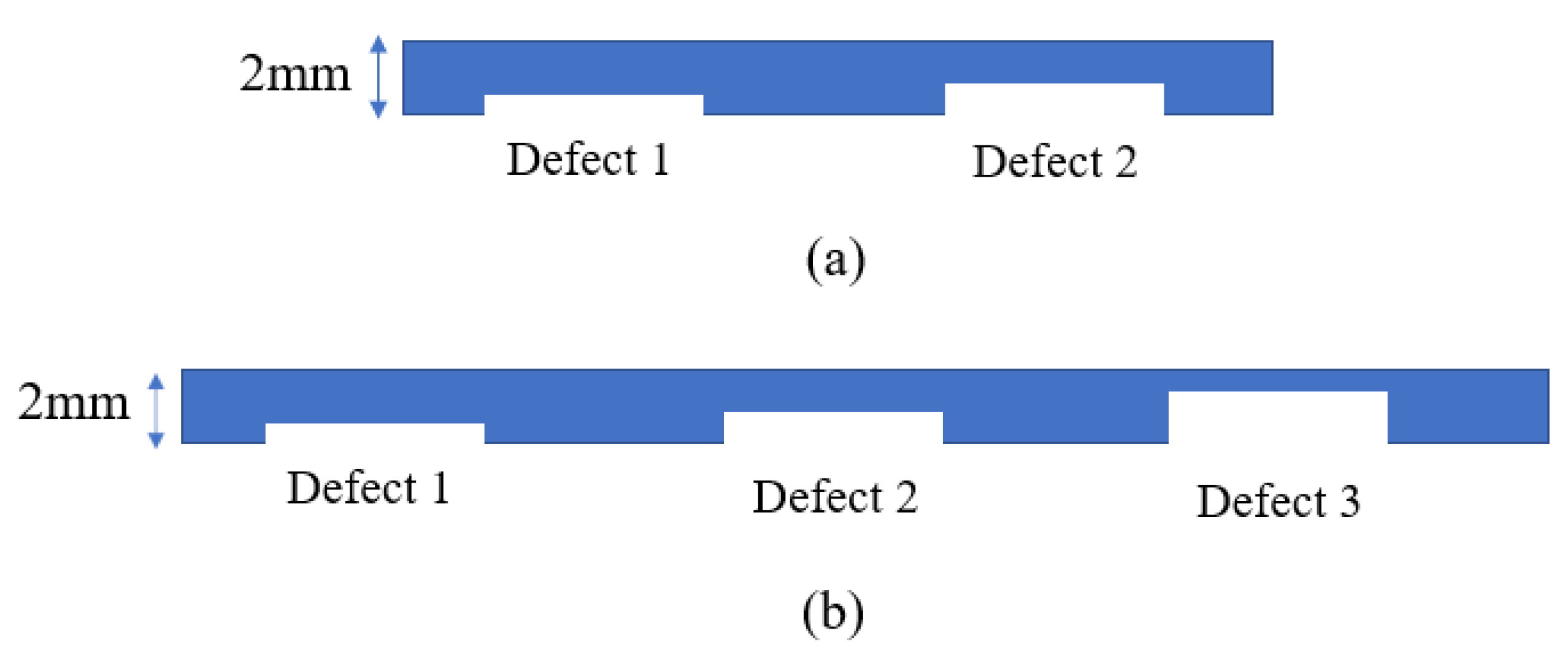
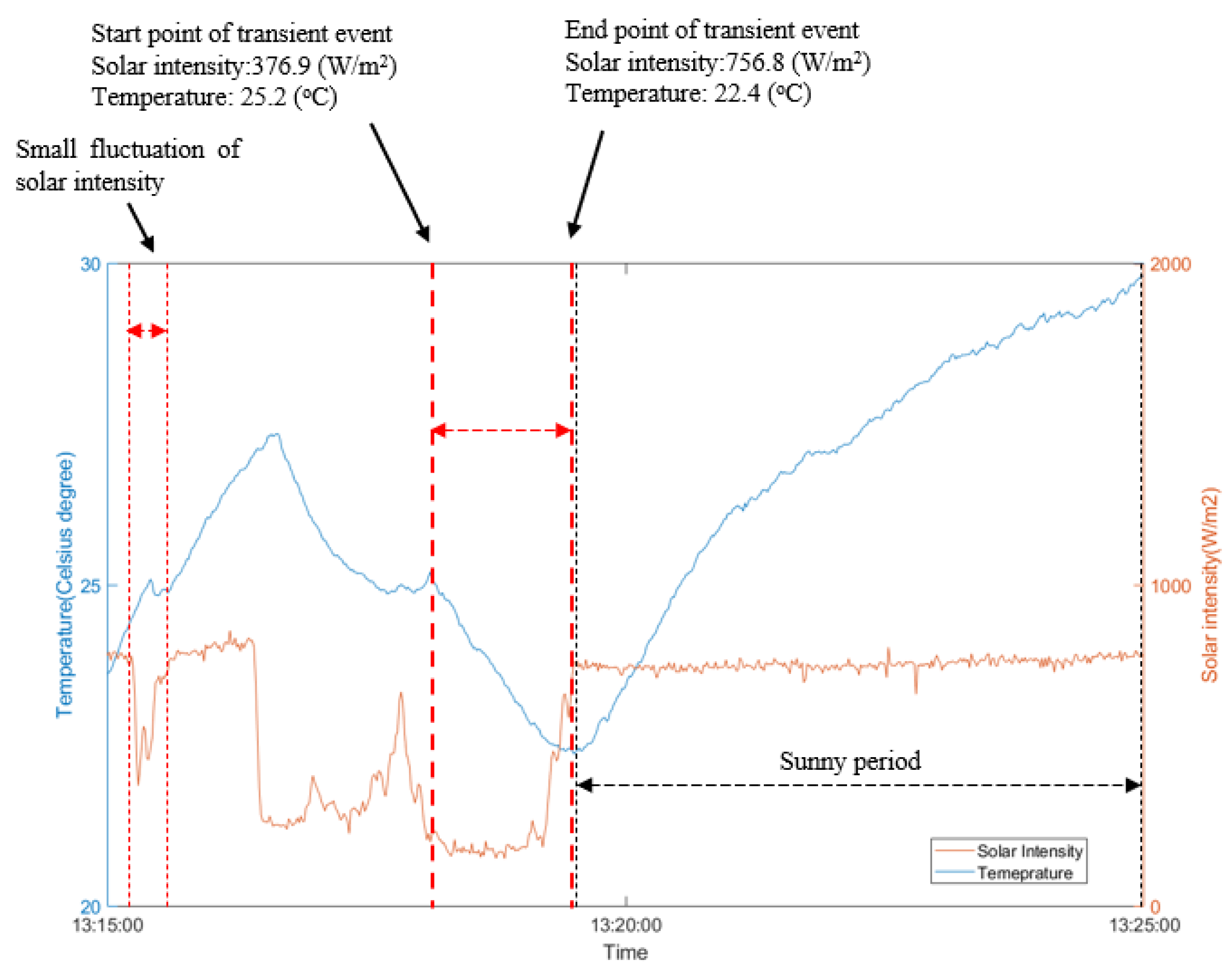
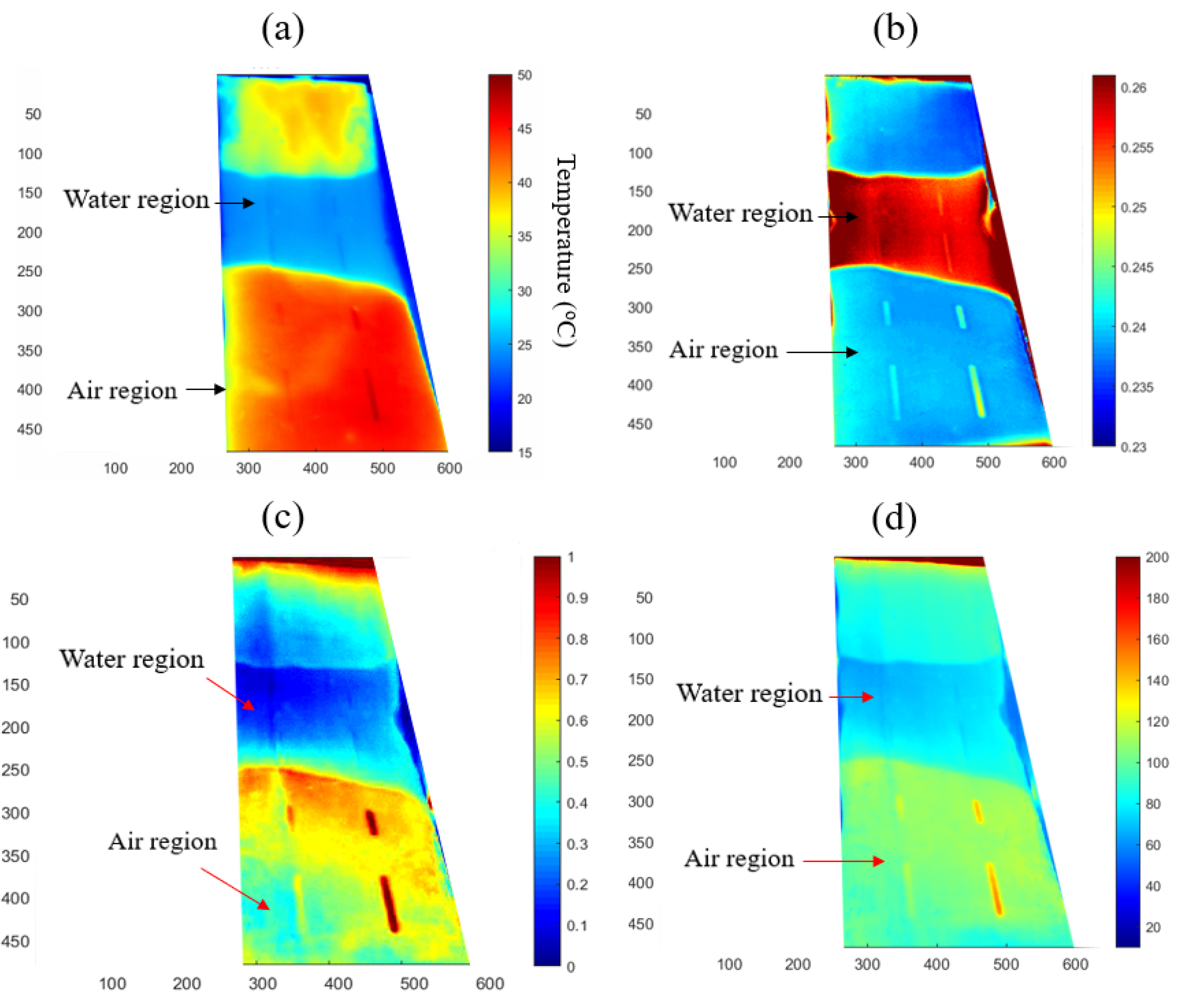


| Characteristic | Specification |
|---|---|
| Detector array size | 640 × 480 pixels |
| Field of view (FOV) | 25° × 19° |
| Minimum focus distance | 0.25 m |
| Noise equivalent temperature difference (NETD) | <0.0 °C @ + 30 °C (+86 °F)/50 50 mK |
| Frame rate | 3–50 Hz |
| Spectral range | 7.5–14 μm |
| Accuracy | ±2 °C |
| Operating temperature | −40–150 °C |
| Detector type | Focal plane array (uncooled microbolometer) |
| Characteristic | Specification |
|---|---|
| Sensitivity | 0.2 mV/Wm−2 |
| Calibrated output range | 0–400 mV |
| Field of view | 180° |
| Mass | 90 g |
| Operating temperature | −40–70 °C |
| Response time | Less than 1 ms |
| Characteristic | Specification |
|---|---|
| Instrument model | Fluke 287 multimeter thermal probe |
| Operating temperature | −20–55 °C |
| Mass | 871 g |
| temperature resolution | 0.1 °C |
| Accuracy | ±1% |
| Response time | Less than 1 ms |
| Material | Density (kg/m3) | Thermal Conductivity (W/m*K) | Specific Heat (J/kg*K) | Thermal Diffusivity (mm2/s) |
|---|---|---|---|---|
| HDPE geomembrane | 940 [33] | 0.44 [33] | 1900 [33] | 0.246 |
| Air (at 20 °C) | 1.2754 | 0.138 | 1000 | 19 |
| Water (at 20 °C) | 997 | 0.6 | 4184 | 0.144 |
| Soil | 1350 [31] | 0.47 [34] | 1900 [35] | 0.183 |
| Scum | 913 [32] | 0.5 [27] | 1400 [36] | 0.391 |
| Defects Number | Defect Length (cm) | Defect Width (cm) | Defect Thickness (mm) | Location of Defects |
|---|---|---|---|---|
| 1 | 5 | 0.5 | 0.5 | Water region |
| 2 | 5 | 0.5 | 1 | |
| 3 | 10 | 0.5 | 0.5 | |
| 4 | 10 | 0.5 | 1 | |
| 5 | 5 | 1 | 0.5 | Air region |
| 6 | 5 | 1 | 1 | |
| 7 | 10 | 1 | 0.5 | |
| 8 | 10 | 1 | 1 |
| Defects Number | Defect Length (cm) | Defect Width (cm) | Defect Thickness (mm) | Location of Defects |
|---|---|---|---|---|
| 1 | 10 | 1 | 0.5 | Soil region |
| 2 | 10 | 1 | 1 | |
| 3 | 10 | 1 | 1.5 | |
| 4 | 10 | 2 | 0.5 | |
| 5 | 10 | 2 | 1 | |
| 6 | 10 | 2 | 1.5 | |
| 7 | 10 | 1 | 0.5 | Air region |
| 8 | 10 | 1 | 1 | |
| 9 | 10 | 1 | 1.5 | |
| 10 | 10 | 2 | 0.5 | |
| 11 | 10 | 2 | 1 | |
| 12 | 10 | 2 | 1.5 |
| Air region and Water Region Identification | Defects Identification on Air Region | Defects Identification on Water Region | Image Quality | |
|---|---|---|---|---|
| Raw thermal image | Yes | Barely visible | Barely visible | Clear |
| Newton’s cooling law method | Yes | Yes | Yes | Clear |
| LPSD method | Yes | Yes | Barely visible | Clear |
| Frame subtraction method | Yes | Yes | Barely visible | Clear |
| Air region and Water Region Identification | Defects Identification on Air Region | Defects Identification on Soil Region | Image Quality | |
|---|---|---|---|---|
| Raw thermal image | Yes | No | 4–6 are visible | Clear |
| Newton’s cooling law method | Yes | No | 4–6 are visible | Clear |
| LPSD method | Yes | No | 5–6 are visible | Clear |
| Frame subtraction method | Yes | Yes | Yes | Not clear |
Publisher’s Note: MDPI stays neutral with regard to jurisdictional claims in published maps and institutional affiliations. |
© 2021 by the authors. Licensee MDPI, Basel, Switzerland. This article is an open access article distributed under the terms and conditions of the Creative Commons Attribution (CC BY) license (https://creativecommons.org/licenses/by/4.0/).
Share and Cite
Ma, Y.; Rose, F.; Wong, L.; Vien, B.S.; Kuen, T.; Rajic, N.; Kodikara, J.; Chiu, W. Detection of Defects in Geomembranes Using Quasi-Active Infrared Thermography. Sensors 2021, 21, 5365. https://doi.org/10.3390/s21165365
Ma Y, Rose F, Wong L, Vien BS, Kuen T, Rajic N, Kodikara J, Chiu W. Detection of Defects in Geomembranes Using Quasi-Active Infrared Thermography. Sensors. 2021; 21(16):5365. https://doi.org/10.3390/s21165365
Chicago/Turabian StyleMa, Yue, Francis Rose, Leslie Wong, Benjamin Steven Vien, Thomas Kuen, Nik Rajic, Jayantha Kodikara, and Wingkong Chiu. 2021. "Detection of Defects in Geomembranes Using Quasi-Active Infrared Thermography" Sensors 21, no. 16: 5365. https://doi.org/10.3390/s21165365
APA StyleMa, Y., Rose, F., Wong, L., Vien, B. S., Kuen, T., Rajic, N., Kodikara, J., & Chiu, W. (2021). Detection of Defects in Geomembranes Using Quasi-Active Infrared Thermography. Sensors, 21(16), 5365. https://doi.org/10.3390/s21165365







